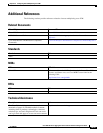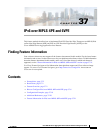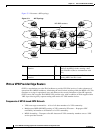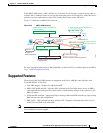
37-4
Cisco ASR 901 Series Aggregation Services Router Software Configuration Guide
OL-23826-09
Chapter37 IPv6 over MPLS: 6PE and 6VPE
Feature Overview
Figure 37-1 illustrates a 6PE topology.
Figure 37-1 6PE Topology
IPv6 on VPN Provider Edge Routers
6VPE is a mechanism to use the IPv4 backbone to provide VPN IPv6 services. It takes advantage of
operational IPv4 MPLS backbones, eliminating the need for dual-stacking within the MPLS core. This
translates to savings in operational costs and addresses the security limitations of the 6PE approach.
6VPE is more like a regular IPv4 MPLS-VPN provider edge, with an addition of IPv6 support within
VRF. It provides logically separate routing table entries for VPN member devices.
Components of MPLS-based 6VPE Network
• VPN route target communities – A list of all other members of a VPN community.
• Multiprotocol BGP (MP-BGP) peering of VPN community PE routers – Propagates VRF
reachability information to all members of a VPN community.
• MPLS forwarding – Transports all traffic between all VPN community members across a VPN
service-provider network.
v6
IPv6
IPv6
MP-iBGP sessions
65141
v6
v4
IPv4
IPv6
v6
v6
IPv6
IPv4
v4
v4
IPv4
6PE
P
P
6PE
6PE
P
P
6PE
V6 IPv6 router on the customer
premises
6PE PE equipment, connected to CEs and entry
points to the MPLS clouds, running a dual
stack IPv6/IPv4 (IPv6 to communicate with
CEs)
V4 IPv4 router on the customer
premises
P Provider routers, core of the MPLS backbone
running MPLS and IPv4 stack


















